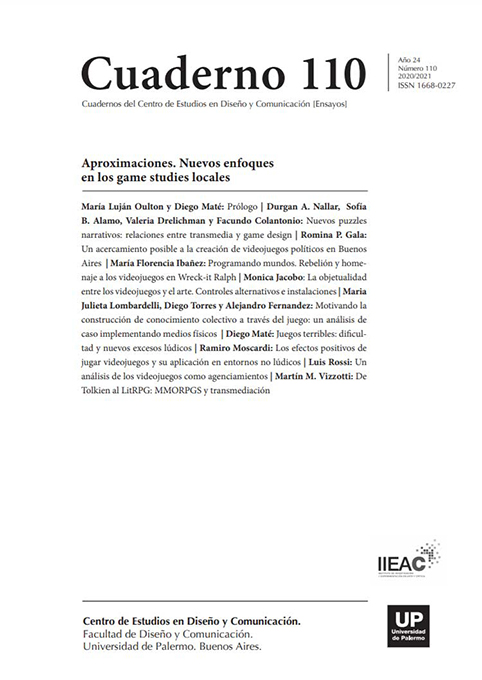La objetualidad entre los videojuegos y el arte. Controles alternativos e instalaciones
Abstract
Festivals and exhibitions in the video game industry feature proposals that incorporate object elements, although games are increasingly downloaded from dedicated platforms. These works explore the interface and in some cases extend into the exhibition space as installations. This work explores the potential of objectivity and its inclusion in videogame-related events, considering the possible routes and loans of works, games and artists between the worlds of art with technology and those of videogames. The pieces that we will consider for the development of this proposal are Line Wobbler, Star Searcher of Dreams and KIDS, productions with different materialities that were exhibited in Buenos Aires in the exhibition Game On! 2019, a space that has the particularity of gathering works that are related to gameplay from different approaches.
References
La Game Developers Conference se realiza desde 1988 en San Francisco, California.
“The Game Developers Conference (GDC) brings game development community together to exchange ideas, solve problems and shape the future of the industry during five days of education, inspiration, and networking. The attendees list includes programmers, artists, producers, game designers, audio professionals and industry leaders.” https://www.gdconf.com/about
“Change the way we play”
Gameplay-the-next-level. https://zkm.de/en/exhibition/2018/09/zkmgameplay-the-nextlevel
A MAZE. https://amaze-berlin.de/
Videogames: Design/Play/Disrupt. https://www.vam.ac.uk/exhibitions/videogames
Alt Ctrl Game Jam. https://altctrlgamejam.com/ 8. Los dos lados de la pantalla. ttps://espacio.fundaciontelefonica.com/evento/inauguracion_videojuegos_la_expo/
Baumgarten, R. (2019). El desarrollo experimental de videojuegos. Recuperado de: https://espacio.fundaciontelefonica.com/noticia/desarrollo-experimental-de-videojuegoscomo-romper-los-limites-por-robin-baumgarten/?ide=64838
Becker, H. (2008). Los mundos del arte: Sociología del trabajo artístico. Buenos Aires: Universidad Nacional de Quilmes. Bishop, C. (2011). Installation Art. Londres: TATE publishing.
Fubini, E. (1988). La estética musical desde la Antigüedad hasta el siglo XX. Madrid: Alianza.
García, M. A. (2011). El arte abstracto. Intercambios culturales entre argentina y Brasil. Buenos Aires: Siglo Veintiuno Editores.
Herrera, M. J. (1997). En medio de los medios. La experimentación con los medios masivos de comunicación en la Argentina de la década del sesenta. Arte argentino del siglo XX, Premio Telefónica de Argentina a la Investigación en Historia de las Artes Plásticas (pp. 69-114). Buenos Aires: Fundación Telefónica.
Manovich, L. (2006). El lenguaje de los nuevos medios de comunicación: La imagen en la era digital. Buenos Aires: Paidós.
Murray, J. (1999). Hamlet on the Holodeck. Cambridge: The MIT Press.
Oulton, L. (2019). Videojuegos en el museo. Nuevos desafíos curatoriales. Cuadernos 98, 93-106. Buenos Aires: Universidad de Palermo.
Pacheco, M. (2003). Arte Abstracto Argentino. Buenos Aires: Fundación Proa.
Palavecino, L. (2019). Videojuegos, arte, naturaleza y maravilla. Un análisis transdisciplinar sobre las posibilidades poéticas de los nuevos medios. Cuadernos 98, 75-92. Buenos Aires: Universidad de Palermo.
Preece, J., Sharp, H. y Rogers, Y. (2002). Interaction Design. Beyond human computer interaction. New York: John Wiley.
Rennó R.y Mattos C. (2013). Activismo en Brasil: los hackerspaces como espacios de resistencia y enseñanza libre. Acta final del II Congreso Internacional Educación mediática & competencia digital: Ludoliteracy, creación colectiva y aprendizajes (pp.1372-1383). Barcelona: Obra social La Caixa. Recuperado de: https://www.uoc.edu/portal/es/symposia/congreso_ludoliteracy2013/conclusiones_actas/ACTAS_DEFINITIVAS_CONGRESO_EDUMED_2013.pdf
Robles Miguélez N. (2017). Makers, fabricantes de ideas. Muriel D. y San Salvador del Valle R.(eds.) Tecnología digital y nuevas formas de ocio (pp.73-84). Bilbao: Universidad de Deusto.
Sellers J. (2001). Arcade Fever. The Fan's Guide To The Golden Age Of Video Games. Philadelphia: Running Press.
Shanken, E. (2009). Art and electronic media. New York: Phaidon.
Sharp, J. (2015). Works of Game: On the Aesthetics of Games and Art. Cambridge: The MIT Press.
Los autores/as que publiquen en esta revista ceden los derechos de autor y de publicación a "Cuadernos del Centro de Estudios de Diseño y Comunicación", Aceptando el registro de su trabajo bajo una licencia de atribución de Creative Commons, que permite a terceros utilizar lo publicado siempre que de el crédito pertinente a los autores y a esta revista.


